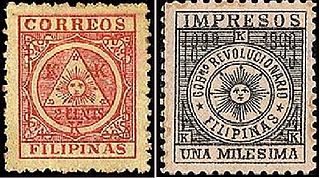
An overprint is an additional layer of text or graphics added to the face of a postage or revenue stamp, postal stationery, banknote or ticket after it has been printed. Post offices most often use overprints for internal administrative purposes such as accounting but they are also employed in public mail. Well-recognized varieties include commemorative overprints which are produced for their public appeal and command significant interest in the field of philately.

Indian postal systems for efficient military and governmental communications had developed long before the arrival of Europeans. When the Portuguese, Dutch, French, Danish and British conquered the Marathas who had already defeated the Mughals, their postal systems existed alongside those of many somewhat independent states. The British East India Company gradually annexed the other powers on the sub-continent and brought into existence a British administrative system over most of modern-day India, with a need to establish and maintain both official and commercial mail systems.

This is an introduction to the postal and philatelic history of Italy.

The Mexican postal system has its roots in the Aztec system of messengers which the Spanish adopted after the Conquest. A postal service was established in 1580, mainly to communicate between the viceroyalty of New Spain with the motherland Spain. During the 18th century, Spain established a formal postal system with regular routes. In 1856, Mexico issued its first adhesive postage stamps, with "district overprints", a unique feature among postal systems worldwide, employed to protect from theft of postage stamps.

Postage stamps and postal history of the Canal Zone is a subject that covers the postal system, postage stamps used and mail sent to and from the Panama Canal Zone from 1904 up until October 1978, after the United States relinquished its authority of the Zone in compliance with the treaty it reached with Panama.

Argentine postage stamps were first issued in 1858 by the Argentine Confederation and nationally by the new Republic's National Postal Service in 1862. Due to the continuing civil wars, a number of provinces and territories, particularly in the then-remote far north and far south, continued to issue their own postage brands and stamps for some time, afterwards; some of these issues have since become collectors' items.

China Zorrilla was an Uruguayan theater, film, and television actress, also director, producer and writer. An immensely popular star in the Rioplatense area, she is often regarded as a "Grand Dame" of the South American theater stage.

Correos de México, formerly named Servicio Postal Mexicano, is the national postal service of Mexico. It has been active for over 100 years, and its system has roots going back to 1580.

This is an outline of Uruguay's monetary history. For the present currency of Uruguay, see Uruguayan peso.
Jan Kobylański was a Polish-Paraguayan businessman. He was the founder of the Union of Polish Associations and Organizations in Latin America the largest Polish immigrant organization of South America. He was also a founder of one of the world's largest companies involved in editing postage stamps, and coins mintage. He has written books on philately, as well as on the mediation policy of the Roman Curia. He was formerly the honorary consul of Poland to Paraguay, and the honorary consul of Paraguay to Santa Cruz de Tenerife, Spain.

Andorra, officially the Principality of Andorra, is a small country located in the Pyrenees mountains and bordered by Spain and France. The official language is Catalan, although Spanish, French, and Portuguese are also commonly spoken.

Colombia is a country in north-western South America. Colombia is bordered by Venezuela, Brazil, Ecuador, Peru, Panama and the Caribbean Sea and the Pacific Ocean. With a population of over 45 million people, Colombia has the second largest population in South America, after Brazil. The capital is Bogotá.

El Salvador became independent from Spain in 1821. It has produced its own stamps since 1867.

This is a survey of the postage stamps and postal history of the Philippines.

This is a survey of the postage stamps and postal history of Spain.

The National Postal Administration, trading as Correo Uruguayo is the state-owned national postal service of Uruguay.

The Ferrer block is a corner block of 15 of the 80 centésimos green 1856 'Diligencia' (Suns) postage stamps, and is regarded by many philatelists as the most important item of Uruguayan philately. Fred Melville, speaking philatelically, called it "one of the seven wonders of the world". It is the largest known multiple of this issue of which only a few blocks are known to exist. Most of the plating information about this issue has been derived from this one block.

Private stamps have been issued in Uruguay by (private) companies instead of the national postal administrations. These stamps were only intended for usage for local inland delivery and were unrecognised by the UPU. The postal services organised by the stagecoach companies, led by Mr. Lapido, started issuing stamps in 1856. These first private stamps came to be known as the Diligencia issue. A second issue, the so-called Soles de Montevideo, followed in 1859.

The Naked Maja is a philatelic name for three postage stamps of Spain of 1930 depicting the La maja desnuda painting (1800) by Francisco de Goya (1746–1828). They are part of a set marking the anniversary of the death of this Spanish artist, and are sometimes incorrectly considered the world's first postage stamp with nudes.
The Classical Monetary System of the Oriental Republic of Uruguay includes the coins minted by the Oriental Republic of Uruguay between the years 1840 and 1855 in the national territory. These coins were minted entirely within the city of Montevideo, first at the "Taller y Armería Jouve" owned by a French artisan named Agustín Jouve and later at the Casa de Moneda de Montevideo or Casa de Moneda Nacional, which was created for this purpose.



























